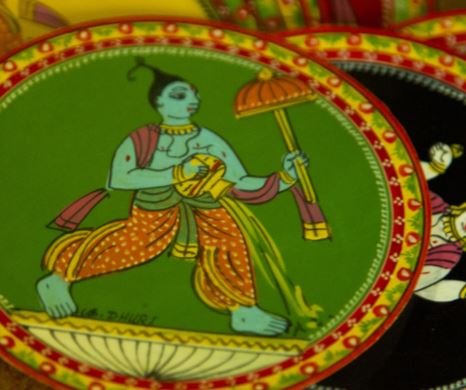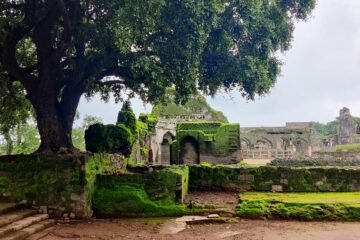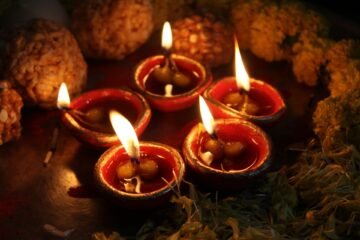Ganjifa~ Ganjifeh (Persian) ~ Playing Cards.
My first memory of playing cards, or taash, is watching my baba play solitaire. He would be sitting alone near the edge of his bed, wearing his typical lungi and baniyan, and laying out cards deftly in four rows. I watched him play as he peered over the cards with great concentration and thoughtfully moved the various cards around.
To oblige the little me, he soon taught me satte pe satta, and as I grew up, rummy. Soon, I could shuffle the cards like a gambler and be obsessed with the excitement of rummy. Back at home, I would beg my father and sister to play rummy almost every day. The mental exercise and the snappy conversations that accompanied the game were an evening high-point every day.
This is why the story of Ganjifa thrills me. The thought that people centuries ago enjoyed the same games as I did seems unreal. And the story of how these cards evolved with time and the places they traveled to is mesmerizing.
What is Ganjifa?
Ganjifa, in Persian, means playing cards. These cards are said to have originated in Persia, and with inspiration from Chinese playing cards. Like the Western card sets we know, the Ganjifa cards also have an ornamental back and a front face demarcating them as face cards/court cards (king or minister) or pip cards (number cards from 1 to 10). Each set has four or more suits, which are divided into strong or weak suits. The cards in strong suits rank higher from 1 to 10, while this ranking reversed in weak suits. With these rules in mind, the game is played as a trick-game like flash or satte pe satta. Every player plays one card per trick, and the player who plays the highest trick gets all the cards of that trick. The player who wins the maximum cards is the overall winner.
Ganifa Through the Ages
The beauty of traditions and cultures is that they are never static. They intermingle and take on the hues of their surroundings. But at the same time, diffuse enough of their individuality into their surroundings so as to make it their own. This is also what happened to Ganjifa cards- which traveled through various lands and kingdoms and changed their shape, colors, and appearance based on the hands that dealt them.
The earliest versions of these cards have been traced back to the late 14th century. They were ornamental rectangular cards played by royalty and the common public alike in the regions of Persia and modern-day Syria and Egypt.
Cultures, in those days, traveled through merchants and invaders. Ganjifa too traveled to India in the early 16th century with the Mughal emperor Babar and became an intrinsic part of local Indian culture.
During the Mughal period, Ganjifa was a popular game, especially among the female quarters. Indeed, the cards are mentioned in famous Mughal literature like Babar’s memoirs, Babarnama, as well as Ain-i-Akbari, written by Abul Fazl during Akbar’s reign.
During this period, Ganjifa was a 96-card game with eight suits. They soon gave up their rectangular shape and became circular. Suited to the interests of the players, each suit depicted a function of the royal court, for example, the king, the treasury, the armory, the mint, etc. These cards were made by a specific artisan community called chitrakaras. Catering to royal tastes, chitrakaras hand-painted the expensive ivory or tortoise-shell cards with natural colors and embellished with gemstones. These cards were called darbar kaalam.
From Royalty to Popularity
Ganjifa came to an abrupt end in Persia, where the game was suppressed by an orthodox Shah Abbas II. However, contrary to these occurrences in its birthplace, the popularity of Ganjifa broke through the walls of class and religion of Mughal regions and spread to the common public outside.
To garner the interest of the masses, artists started producing more Hindu forms of Ganjifa. Also, the expensive cards of royalty adapted to the needs of the public by recreating themselves on cheaper canvases made of wood and palm leaf. These cards were simpler in design and were called bazaar kaalam.
The game soon spread in other regions of India and migrating artisans formed local specialties. This included the Sawantwadi Ganjifa from Maharashtra, Navadurga Ganjifa from Odisha, Rajasthan and Gujrat Ganjifa, Kashmir Ganjifa, Nepal Ganjifa, and the Mysuru Ganjifa. The local artisans who created these cards were often patronized by local royalties like Bhosale king Khem Sawant III of Sawantwad, Maharashtra.
Types of Ganjifa Sets
Chitrakaras usually color-code different suits in the Ganjifa sets. Thus, depending on the number of suits in the set, the Ganjifa set would be called dasrangi (having then colors), vararangi (having twelve colors), chaudarangi (having fourteen colors) or solarangi (having sixteen colors). However, an even more important differentiation can be seen based on regional themes of the Ganjifa. Some of them are:
1. Mughal Ganjifa
This was a set of 96 cards with 8 suits of 12 cards each. Each suit was of a different color. The theme of the cards was different court roles like a king, treasury, etc, however, the iconography varied area to area due to its broad regional spread. In this set, Taj, Safed, Samsher, and Ghulam were strong suits while Chang, Surkh, Barat, and Qimash were weak suits. These cards were popular in the regions of Rajasthan, Gujarat, Kashmir, Mysore, Maharashtra, and Odisha.
2. Dashavatara Ganjifa
Among the most popular alternate forms, especially in the Sawantwad region, was the Dashavatara form. This set of 120 cards symbolized the cards with the ten avatars of Vishnu. There are 10 suits of 12 cards each. These cards were popular in areas of Maharashtra, Odisha, and Bengal.
Apart from these, there are some local themes including:
3. Ashtadigpala Ganjifa
Ashta~ Eight, Diga~Direction, Pala~Guardian. The theme of these cards is based on the guardians of the eight sacred directions in Hindu mythology. These cards have been inspired by the Mukteshwar temple and Raja Rani temple of Odisha and are popular in Chikiṭi in Odisha.
4. Navagraha Ganjifa
These are based on the nine planets of the solar system, each of which is considered a deity in Hindu mythology. Like the nine planets, the set has nine suits. This theme is from Odisha.
5. Rashi Ganjifa
This theme from Parlakhemundi, Odisha, is based on the twelve zodiac signs. It contains twelve suits.
6. Ramayana Ganjifa
Ramayana Ganjifa from Odisha is based on the Ganjapa tradition of Odisha and carries the Ramayana theme. It can have eight, ten, or twelve suits.
7. Ashta Malla Ganjifa
Ashta~ Eight, Malla ~ Wrestlers. Meaning eight wrestlers, the set depicts the Hindu god Krishna wrestling various demons.
8. Mamluk Kanjifa
The very rare Mamluk Kanjifa is one of the few Kanjifas where each suit has three court cards, the king, the first vizir, and the second vizir.
Cultural Significance of Ganjifa
Ganjifa was not merely played for entertainment. It helped in boosting powers of memory retention, dissemination of traditional knowledge/mythological stories, and also in washing away one’s sins. For example, consider the Dasavatara Ganjifa, which has the ten forms of Hindu God Vishnu carefully hand-painted on twelve cards. When players play this game, they have to repeat the name of the Vishnu avatars. ‘My matsya won!’, ‘Your kurma is left!’. As per Hindu scriptures, it is believed that invoking the game of God so many times helps in washing away one’s sins, and this was done subtly by the Ganjifa game as well. Due to this cultural and religious relevance of Ganjifa, the cards are never used to play for money or gambling.
The Circular Cycle of Ganijfa-Making
The Canvas
In modern times, Ganjifa cards are made of around six layers of paper layered together with glue or more traditionally paste derived from tamarind seeds. These are then primed with lime and then lacquered with Indian shellac or natural resin. The lacquer lends stiffness, smoothness, and durability to the cards.
In Odisha, Ganjifa cards are still made of cloth derived from bleached cotton waste rags. Like the paper counterparts, these are glued with tamarind seed extract and then starched for stiffness. The chalk paste is applied for smoothness over which intricate painting is done with paints.
The Colors
In traditional houses, the paints are mineral or vegetable-based and the paintbrushes are made of squirrel hair, but now both are rapidly getting replaced with synthetic material. Among natural colors are white derived from powdered conch shells, green from leaves, black from lamp soot, red is a mineral-derived color from a stone called Hingulal. Similarly blue is also mineral-derived from a stone called Khandneela as is yellow from a stone called Hartal.
After the canvas is ready and cut into shape, the artisans pray to God and then make a white outline of the figure to be painted on the card’s back. They then paint the rest of the painting and give it a finishing touch by highlighting the eyes with white. Much like the circular shape of cards, the process of making Ganjifa cards is also circular. It starts and ends with white.
Ganjifa in the Present Day
The advent of cheaper western playing cards in the 18th Century led to a sharp decline in demand for Ganjifa cards. So much so, that the art form has now been declared an endangered artform by the government of India. The use of Ganjifa cards is near extinct in other countries and India is probably the only country that still produces these playing cards.
Now the main areas which still manufacture Ganjifa cards are Sawai Madhopur and Karauli in Rajasthan, Sheopur in Madhya Pradesh, Fatehpur District in Uttar Pradesh, Sawantwadi in Maharashtra, Balkonda, Nirmal, Bimgal, Kurnol, Nossam, Cuddapah, and Kondapalle in
Andhra Pradesh, Mysore in Karnataka, Puri, Sonepur, Parlakhemundi, Barapalli, Chikiti and
Jayapur in Odisha, Bishnupur in Bengal and Bhaktapur, Bhadbaon and Patan in Nepal.
This favorite pastime of ancient evenings across regions and centuries is now on the verge of extinction due to low awareness and demand. Ganjifa survived numerous rulers, invasions, and the travails of time. Will this ancient game be able to survive the modernized world?






the reason its endangered, is because it hand-painted. I do respect the artists, but due to hand-painted card stock. It becomes very costly for common to purchase it.
If its not published then it will definitely go extinct.
There’s time for everything, maybe its time for these Card to see the light of Publishing houses!